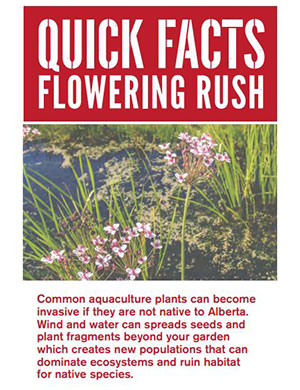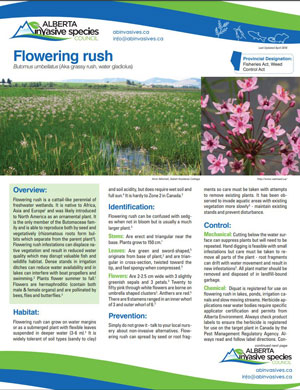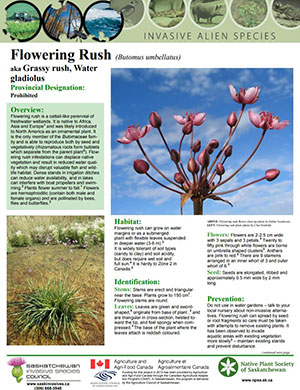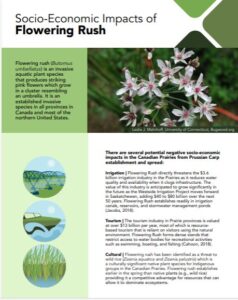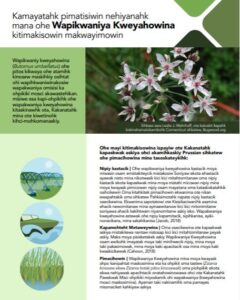Flowering Rush (Butomus umbellatus)
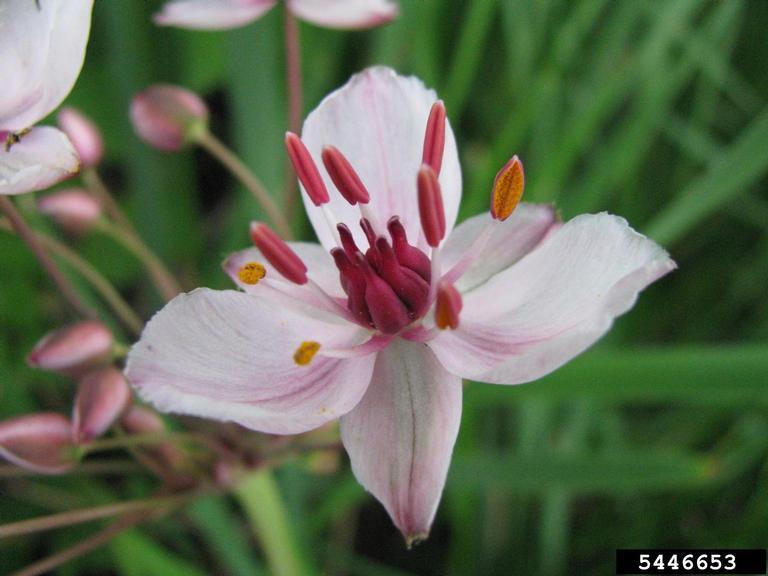
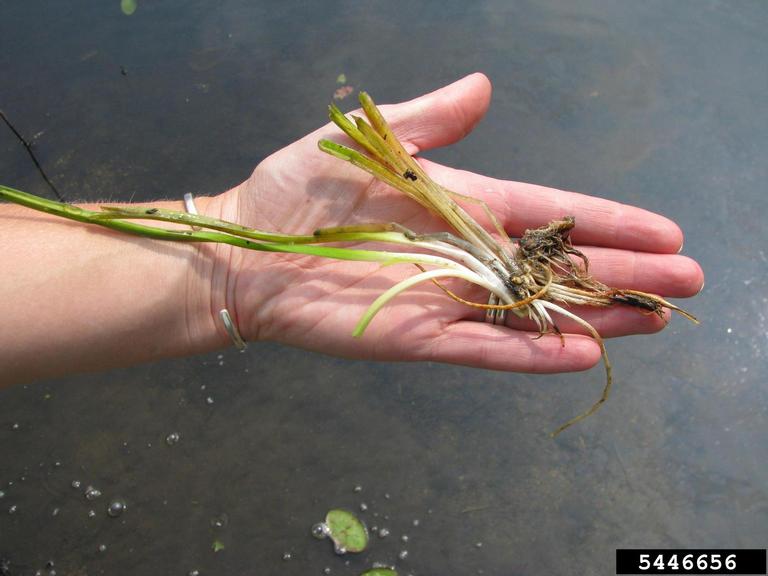
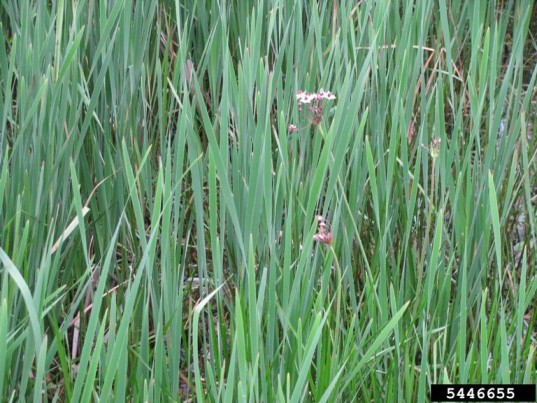
Photo credit: Leslie J. Mehrhoff, University of Connecticut, Bugwood.org
Order: Alismatales
Family: Butomaceae
Flowering rush (Butomus umbellatus) is an invasive aquatic plant species that resembles a large sedge. It produces aesthetically pleasing, pink flowers which grow in a cluster that resembles an umbrella. It is invasive to North America and is found in all provinces in Canada and most of the northern United States. This species spreads very easily and can cause several negative impacts. It displaces native vegetation and alters water quality, leading to reduced biodiversity and alterations to fish and wildlife habitat. It can impact water supply when it establishes in irrigation canals, reservoirs, and stormwater management ponds. Flowering rush also impacts water related recreational activities such as swimming, boating, and fishing by forming dense stands that restrict access to the water body.
To help prevent the establishment and spread of flowering rush, remember to clean, drain, and dry all outdoor equipment and avoid planting invasive species in gardens.
Flowering rush is an invasive aquatic plant species that resembles a large sedge and produces aesthetically pleasing, pink flowers. A typical plant produces 20 – 50 flowers which emerge from early summer to mid fall and grow in a cluster that resembles an umbrella. Flowering rush can reach up to two metres tall, with leaves that are triangular in cross section, which narrow and spiral toward the leaf tip. When this species is flowering it is very distinctive, however when it is not flowering, identification can be challenging.
Flowering rush is typically found as an emergent plant in shallow waters (shoreline to about three metres depth) of wetlands, irrigation canals, lakes, and rivers. It can also modify its growth form in deeper waters (typically three to six metres deep), where it can be found as a submerged plant that is non-flowering and has flexible, ribbon like leaves. It requires wet soil and full sun, and as a wide tolerance of substrate type (sandy to clay) and soil acidity.
Flowering rush is native to Africa, Asia, and Europe, and is invasive in North America. It was first recorded in North America along the shores of the St. Lawrence River near Montreal in 1897. It quickly spread into the Great Lakes and today is found in all provinces in Canada and most of the northern United States. It was likely introduced through the ballast waters of trans-Atlantic ships and as an ornamental plant in water gardens.
To see a distribution map on EDDMapS, click here.
Flowering rush spreads easily as minor disturbances such as moving water, ice movements, waterfowl, and boats can easily break off fragments of the plant and establish new populations. Fragments of flowering rush are very hardy and can survive out of water for several weeks, increasing the likelihood of human mediated transport between water bodies by boats or equipment.
Efforts to remove flowering rush need to be conducted very carefully, as improper management (i.e. not removing all portions of the plant) can cause further spread. It is important to clean, drain, and dry all outdoor equipment, avoid planting invasive species like flowering rush in water gardens, and report any sightings of this species.
Like most aquatic invasive plant species, flowering rush can cause several negative ecological, social, and economic impacts:
- Flowering rush is known to displace native vegetation and dominate aquatic environments by forming dense monocultures, leading to reduced biodiversity and major alterations to fish and wildlife habitat
- This species can cause increases in nutrient levels and declines in dissolved oxygen levels, leading to algal blooms, increased water turbidity, reduced water quality, and light restrictions
- Flowering rush has been found in dense stands in irrigation canals, reservoirs, and stormwater management ponds, resulting in reduced water flow and distribution, increased sedimentation, and increased maintenance costs
- Flowering rush is a significant problem for recreational water users and shoreline residents as it can limit access to water bodies for swimming, boating, and fishing and can interfere with boat propellers.
Factsheets
Research
Cahoon, L. M. (2018). Development of Best Strategies for the Control of Butomus umbellatus L. (Flowering Rush) In Alberta (Unpublished master’s thesis) [University of Calgary]. https://doi.org/10.11575/PRISM/5441
Hroudová, Z., Krahulcová, A., Zákravský, P., & Jarolímová, V. (1996). The biology of Butomus umbellatus in shallow waters with fluctuating water level. Hydrobiologia, 340, 27–30. https://doi.org/10.1007/bf00012730
Lui, K., Thompson, F. L., & Eckert, C. G. (2005). Causes and consequences of extreme variation in reproductive strategy and vegetative growth among invasive populations of a clonal aquatic plant, Butomus umbellatus L. (Butomaceae). Biological Invasions, 7(3), 427–444. https://doi.org/10.1007/s10530-004-4063-3
Madsen, J. D., Wersal, R. M., & Marko, M. D. (2016). Distribution and Biomass Allocation in Relation to Depth of Flowering Rush ( Butomus umbellatus ) in the Detroit Lakes, Minnesota . Invasive Plant Science and Management, 9(3), 161–170. https://doi.org/10.1614/ipsm-d-15-00028.1
Other Resources
- Ontario’s Invading Species Awareness Program: Flowering Rush Profile
- Ontario Invasive Plant Council: Flowering Rush (Butomus umbellatus): Best Management Practices in Ontario
- Columbia Basin Cooperative Weed Management Area: Columbia Basin Flowering Rush Management Plan: A regional strategy to address Butomus umbellatus throughout the Columbia Basin.

